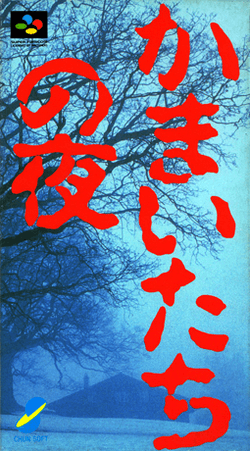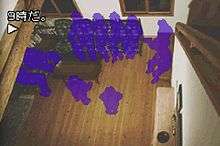Banshee's Last Cry
| Banshee's Last Cry | |
|---|---|
 Japanese Super Famicom cover | |
| Developer(s) | Chunsoft / Spike Chunsoft |
| Publisher(s) |
‹See Tfd›
|
| Designer(s) |
Kazuya Asano Kōichi Nakamura |
| Platform(s) | Super Famicom, PlayStation, Game Boy Advance, PC, mobile phones, iOS, PlayStation Vita |
| Release date(s) |
Super Famicom
PlayStation
Game Boy Advance
Mobile Phone
PC
iOS
PS Vita
|
| Genre(s) | Visual novel, adventure |
| Mode(s) | Single player |
Banshee's Last Cry[1] (かまいたちの夜 Kamaitachi no Yoru, lit. "The Night of the Sickle Weasel") is a visual novel video game developed and published by Chunsoft (later Spike Chunsoft). The game was first released in Japan for the Super Famicom on November 25, 1994, and has since been ported to PlayStation, Game Boy Advance, PC, and mobile phones. An English localized version (including changes to the setting and character names) of the game was translated by Jeremy Blaustein and released by Aksys Games on January 24, 2014 for iOS, with a release on Android devices to follow.[1][2] The story-line was written by Takemaru Abiko and production was directed by Kazuya Asano and Kōichi Nakamura.
Banshee's Last Cry was the second sound novel developed by Chunsoft, and its popularity brought a myriad of other companies to develop similar games. The term "sound novel" was originally a registered trademark of Chunsoft, but is now regarded as a whole genre of its own. The game sold close to a million copies (including remakes and ports), making it a financial success as well.
Gameplay

The game plays similarly to a gamebook. The player reads the text from the game screen, and makes choices which will affect the outcome of the game.
Plot
Characters
- Tōru (透 Tōru): The main character of the game. He was given the name Tōru Yajima (矢島 透 Yajima Tōru) in later installments, but was simply referred to as "Tōru" in the original version. He has a one-sided crush on Mari, and was overjoyed when she invited him to go on a skiing trip with her. In the iOS release, he was renamed Max.
- Mari (真理 Mari): The heroine of the story. She was given the name Mari Kobayashi (小林 真理 Kobayashi Mari) in later installments, but was simply referred to as "Mari" in the original version. She attends the same college as Tōru, and her uncle owns a ski lodge in Shinshū. It is yet to be known whether she has feelings for Tōru. In the iOS release, she was renamed Grace.
- Jirō Kobayashi (小林 二郎 Kobayashi Jirō): The owner of the ski lodge, and Mari's uncle. He opened the ski lodge Spur (シュプール Shupūru) (renamed Snowflake Inn in the iOS release) after quitting work as a salaryman. He is also a very good cook. He is renamed William Forrest in the iOS release.
- Kyōko Kobayashi (小林 今日子 Kobayashi Kyōko): Jirō's wife. Dislikes quarreling with others. Unlike her husband, she is a disastrous cook. She is renamed Colleen Forrest in the iOS release.
- Seiichi Kayama (香山 誠一 Kayama Seiichi): A company executive from Osaka. He is portrayed as the stereotype of someone from the Kansai region. He can be quite cowardly at times. In the iOS release, he is renamed Chase Buchanan.
- Haruko Kayama (香山 春子 Kayama Haruko): Seiichi's wife. A quiet, thin, and attractive woman. She is renamed Amber Buchanan in the iOS release.
- Toshio Kubota (久保田 俊夫 Kubota Toshio): A sixth-year college student working and living at the lodge. He spends most of his time skiing rather than studying. In the iOS release, he is renamed Bobby Trottier.
- Midori Shinozaki (篠崎 みどり Shinozaki Midori): A young woman also working and living at the lodge. She appears to be in her 20s, and is in a relationship with Kubota. She is renamed Abby McCarthy in the iOS release.
- Kanako Watase (渡瀬 可奈子 Watase Kanako): One of the three OLs staying at the lodge. She has long hair and an outspoken personality. She is renamed Tiffany Oakley in the iOS release.
- Aki Kawamura (河村 亜希 Kawamura Aki): One of the three OLs staying at the lodge. Short haired, and wears glasses. She is renamed Molly Starks in the iOS release.
- Keiko Kitano (北野 啓子 Kitano Keiko): One of the three OLs staying at the lodge. Slightly chubby, and loves to eat. She chose the lodge as the vacation spot because of Kobayashi's exceptional cooking. She is renamed Debbie Mason in the iOS release.
- Yōsuke Mikimoto (美樹本 洋介 Mikimoto Yōsuke): A tall, bearded cameraman. Very sociable. In the iOS release, he is renamed Jonas Faberge.
- Ichirō Tanaka (田中 一郎 Tanaka Ichirō): A suspicious man wearing a trenchcoat with a hat and sunglasses at a ski resort. He is renamed John Jones in the iOS release.
- Jenny (ジェニー Jenī): A cat kept at the ski lodge. Was missing when Tōru and Mari first arrived. She is renamed Ruby in the iOS release.
Story
The game revolves around Tōru and his girlfriend Mari, who are suddenly drawn into a horrible murder mystery while on vacation at a skiing lodge. The first part of the games develops as a crime-solving adventure. Additional murders occur if the player is unable to find clues, and the story culminates into a horror movie-esque ending.
When the player completes the main story with a certain number of different endings, two additional stories (the occult chapter and spy chapter) are unlocked. When all three stories are finished with every possible ending, two more self-parodical stories also become available. Fulfilling one final requirement allows the player to unlock a parody of Torneko no Daibōken: Fushigi no Dungeon.
The additional stories cover a wide variety of themes, and are completely unrelated to each other and to the main story. Though the same set of characters is used throughout the game, the character settings differ significantly in each story.
Development
Writing competition
This competition was announced in the official guidebook for the game, which was published shortly after the release of the Super Famicom version, and called for readers to write their own storylines based loosely on the events in the game. Unfortunately, only a very short period of time was allotted for submissions, and many readers were unable to finish their storylines in time. The 10 best storylines (including those in short story and game book format) were published in a book titled Anata dake no Kamaitachi no Yoru (あなただけのかまいたちの夜 lit. "Your Own Night of the Sickle Weasels"). The book was a great success, despite the fact that it only targeted readers who had played the game and read the official guidebook. Prize money was awarded to the writers' whose compositions made it into the book.
A similar competition was started upon the release of Kamaitachi no Yoru 2. Anata dake no Kamaitachi no Yoru went out of print after several years, but was re-published following the release of the game sequel.
Music
Composed by Kōjirō Nakashima and Kōta Katō, the game music gained significant popularity and was often reused in television shows concerning Aum Shinrikyo, which was at the center of the Japanese media during the 1990s. The background music for accusing the murderer continues to be used in related television shows in Japan. Two of the songs, "Sequence" and "Two People Return Alive" were orchestrated for Orchestral Game Concert, vol. 4 of the Orchestral Game Concert series.
Graphics
Real pictures were used in the game background, most of which were taken at the "Knulp" lodge, located in Hakuba, Nagano. Exceptions are the background for bathrooms and the wine cellar, which were taken using miniatures. All in-game characters are animated silhouettes.
The English localization changed the setting including the graphics to a lodge in British Columbia.
Ports
Releases
Banshee's Last Cry has been ported on the PlayStation as "Kamaitachi no Yoru Tokubetsu Hen" (December 3, 1998) and the Game Boy Advance as "Kamaitachi no Yoru ~Advance~" (June 28, 2002). It has also been released on the J-PHONE as "Kamaitachi no Yoru mini" (April 1, 2002), and on PC as "Kamaitachi no Yoru internet" (July 1, 2002). i-mode began its own release on January 30, 2004. The main story was also included in the PlayStation 2 sequel Kamaitachi no Yoru × 3, with minor changes made to the script. On January 24, 2014, Aksys Games released the game in English for iOS.[3]
Changes
- PlayStation version
- A flow chart was added, and choices were colored according to whether they had been chosen in previous playthroughs. The player may also replay past scenes.
- Vibration added.
- Two more additional stories were added.
- Changes in unlocking the extra storylines and parodies.
- Improved graphics.
- Added background information on characters.
- Game Boy Advance version (comparison with PlayStation version)
- The main character's name is changed to "Tōru Yajima" following the changes made in Kamaitachi no Yoru 2. Mari also becomes "Mari Kobayashi."
- A commercial message for the sequel can be unlocked.
- No vibration.
- The two extra stories added in the PlayStation version were not included due to lack of cartridge space.
- Some minor changes in the script.
Related media
Radio drama
A radio drama version has been released on Compact Disc. The characters are the same, but the story-line is completely different, involving biochemical weapons. Hikaru Midorikawa voiced Tōru, and Yumi Tōma voiced Mari.
Television drama
The two-hour drama version was produced by TBS, and aired on July 3, 2002. Kamaitachi no Yoru 2 was set to be released on July 18 of the same year, and the first edition of the game contains a bonus DVD of the entire drama. Like the radio drama version, the TV drama is not a rendition of the actual game (the premise is that fans of Kamaitachi no Yoru had gathered to shoot a film based on the game, when one of the cast members is mysteriously killed). The drama does attempt to recreate the tense, mysterious atmosphere of the game.
Reception
On release, Famitsu magazine scored the Game Boy Advance version of the game a 31 out of 40,[4] granting the Super Famicom version a 30 out of 40.[5]
See also
References
- 1 2 3 http://www.aksysgames.com/2014/01/24/tales-of-murder-await-you/
- ↑ https://twitter.com/Aksys_June/status/426873628236333057
- ↑ http://www.animenewsnetwork.com/news/2014-01-24/aksys-games-releases-kamaitachi-no-yoru-visual-novel-on-ios
- ↑ ゲームボーイアドバンス - かまいたちの夜 ~アドバンス~. Weekly Famitsu. No.915 Pt.2. Pg.122. 30 June 2006.
- ↑ おオススメ!! ソフト カタログ!!: かまいたちの夜. Weekly Famicom Tsūshin. No.335. Pg.115. 12–19 May 1995.
External links
- Official page (iOS version)
- Virtual Console page (Japanese)
- Knulp (the ski lodge used in background graphics) (Japanese)
- Instruction manual (Super Famicom) at Giant Bomb